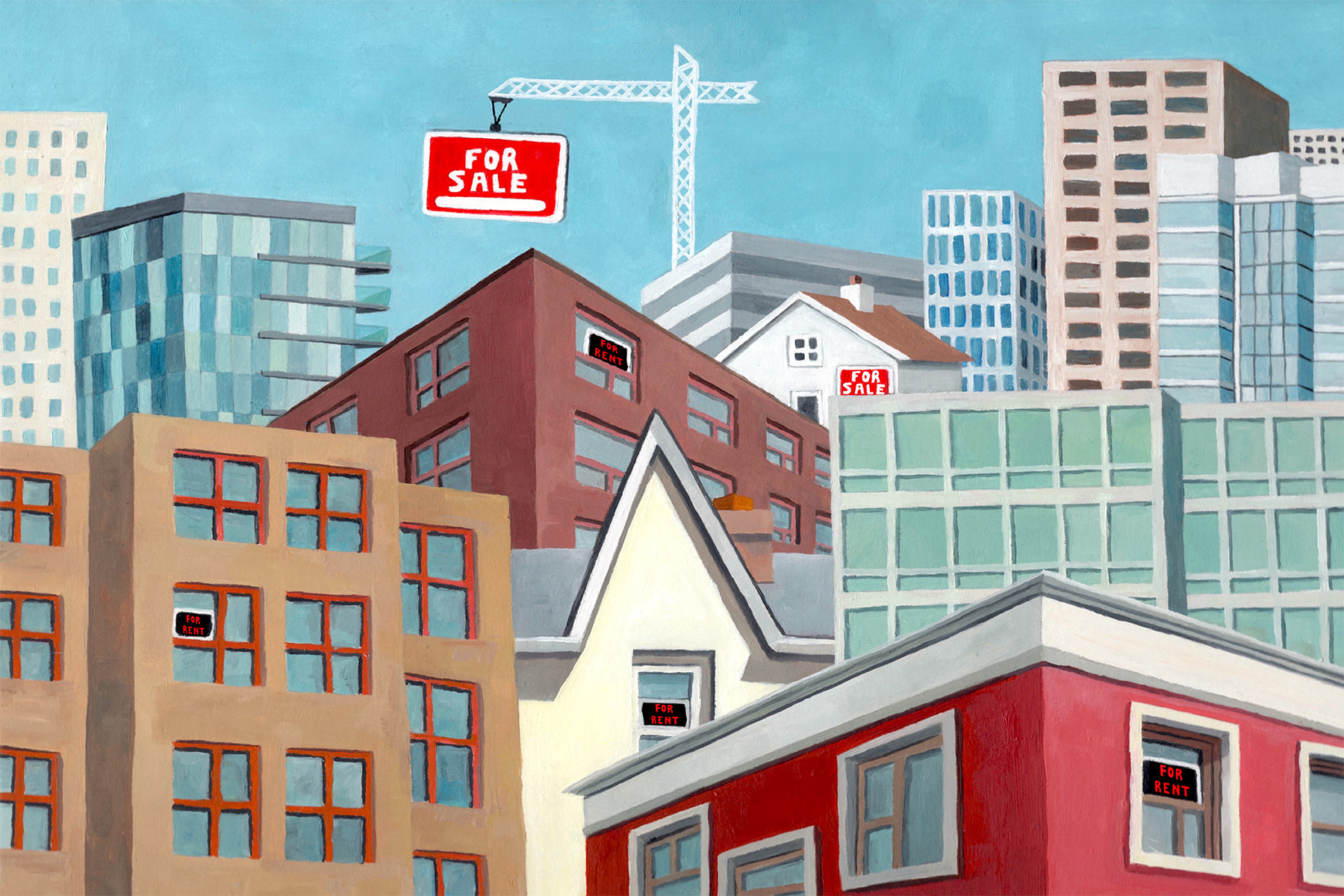I have a confession: I’m in my forties and I’m a renter. What’s more, I might be renting forever.
I live in a two-bedroom apartment with my son in a desirable Vancouver neighbourhood—I’m not hard done by—but I’d always expected that I would eventually buy a place of my own. In my twenties, home ownership felt too far on the horizon to worry about. In my thirties, I pulled together money for a down payment and shopped around for a family-sized condo, only to realize that, at my price point, it would mean moving to the distant suburbs. I decided to keep saving. Now, in my forties, I’ve found that my funds can’t keep up with rising home prices—the average for Metro Vancouver hit nearly $1.2 million in recent months. The experience has been like watching a train leave the station without me—and it’s not coming back.
The prospect of being a renter for life carries a feeling of guilt. I’ve heard it described as “renter’s shame.” Maybe I didn’t save hard enough. Maybe I should have elbowed into a more affordable area, even if it meant buying an undersized, overpriced studio. Regardless, the outcome is clear: I’ve failed to achieve one of our country’s most commonly held dreams.
I’m not alone, of course. According to the 2021 census, roughly one-third of Canadians rent. That number is higher in urban centres like Vancouver, Toronto, and Montreal, where about half of all residents are tenants. What’s more, the numbers in this camp are rising quickly: over the past decade, growth in renters was twice that in owners. Yet renting is still considered a temporary phase, a stepping stone. In a 2019 campaign speech, BC Liberal party leader Andrew Wilkinson described it as a “wacky time of life,” “fun,” “enjoyable,” and a “rite of passage.” For many Canadians, of course, that’s simply not the case.
With the prices of homes skyrocketing over the pandemic—the average for detached houses in Canada was roughly $632,000 in November, even as interest rates soared—many people are now facing a future of renting for life. In a 2022 survey by insurance firm Canada Life, almost half of the respondents who rent said they would continue to do so indefinitely. Those surveyed cited a lack of cash, fear, and uncertainty as reasons for staying on the sidelines. A similar survey done in 2021 found that, among respondents aged eighteen to twenty-eight living in urban centres, half had given up on the dream of ever owning a single-family home.
At the same time, rents have risen sharply due to a short supply of housing stock, and the problem shows few signs of abating. In December, rental prices in Vancouver and Toronto had jumped by more than 20 percent compared to a year ago. The increase was even more dramatic in some smaller communities like Kitchener, where rates shot up by over 30 percent. Renters are being squeezed on all sides, making the idea of saving up for a down payment feel outright impossible.
In 2023, it seems like renters just can’t win. But what if it weren’t this way? Canada once had a thriving rental stock. What would it take for us to reconceive our cities so renting is once again considered a credible long-term option—not just for the young but for everyone?
The history of urban Canada is a history of renters. Before the twentieth century, home owners were often a mix of wealthy aristocrats and rural homesteaders. In North America, the rise of the middle class and the dream of having a place of one’s own really took off following the Second World War, fuelled by lower building costs and the introduction of insured mortgages, which made financing more accessible. Suburban single-family homes with white picket fences became synonymous with a certain kind of material success, and home ownership rates in Canada soared from around 40 percent in 1940 to nearly 60 percent by the 1970s. According to the Toronto Regional Real Estate Board, in 1977, the average home price was just over $64,000.
In the mid-twentieth century, inner-city areas designated for high-density housing tended to be, by default, reserved for rental units, according to David Hulchanski, professor of housing and community development at the University of Toronto. And there were a lot of them.
Rental stock—a mix of privately owned apartments and publicly funded social housing—steadily increased between 1950 and the late 1960s, when more than 100,000 units were built every year with the support of government subsidies. Social housing—featuring rents set below the market rate—followed a similar arc, with the federal government funding some 20,000 units every year through the 1960s and ’70s.
With the introduction of the condominium form of home ownership in the early 1970s, however, our cities began to change, Hulchanski says. Government funding for rentals dried up through the 1980s as austerity measures took hold, culminating in the federal government cancelling all social housing funding in 1993.
At the same time that new rental unit numbers were declining, home ownership incentives were ramping up. The Canadian Home Stimulation Program was created in the early 1980s, offering grants for buyers. Meanwhile, the Graduated Payment Mortgage Plan offset costs by lowering initial monthly mortgage payments. The biggest incentive of all, however, was introduced in 1972, when the federal government exempted homes from the newly introduced capital gains tax. This means that any profits made from buying and selling a home are tax free as long as it’s your principal residence—a huge benefit, particularly as prices skyrocketed.
Hulchanski says that most new rentals today are offered through privately owned condos and basement suites, which tend to be less stable (owners sell; tenants are displaced). Many of these would-be rental units are also now being used as short-term rentals on platforms like Airbnb instead. And demand is vastly outstripping supply, Hulchanski says, which is now helping drive up prices. The vacancy rate across the country is around 3 percent. But in Toronto and Vancouver, it’s at 1.4 and 1.2 percent respectively. In December, just as home prices were starting to soften, the median rent for a one bedroom in Vancouver reached a new high of nearly $2,600. The median rent for a two bedroom was nearly $3,600, up a whopping 18.9 percent from a year earlier—all despite the province’s rent-control regulation. In Toronto, the increases have been even steeper, with the average rent going up nearly 23 percent from a year earlier in December.
Those hikes directly impact people who can least afford them, says Hulchanski. Renters, in general, earn about half of what home owners do, and the income disparity between the two groups is only getting wider. The share of renters in the top 20 percent of the income distribution has shrunk from 14 percent in the late 1960s to 6 percent now. According to Hulchanski’s analysis, over half of renter households are on the bottom 50 percent of the income ladder.
A higher income isn’t the only gateway to home ownership, as intergenerational wealth has also become a big factor. A 2021 report by CIBC found the average gift for first-time home buyers rose to $82,000 in 2020, compared to $52,000 in 2015. Under 30 percent of Canadians received financial help from their families in 2020. “If you didn’t pick your parents carefully, it’s going to take you longer to become a home owner, or you may not become a home owner,” says Hulchanski.
Hulchanski argues that the government has created a two-tiered housing system: those who own and those who don’t. For those able to get into the housing market, the financial benefits have been huge—particularly over the pandemic. Renters, on the other hand, have had to face steadily increasing rents and an ever-present risk of being displaced for renovations or property flipping. In many cities, tales of “renoviction”—families being evicted for minor renovations in order for the landlord to charge a new tenant a significantly higher rent—are widespread. Many rental buildings are also now reaching the end of their lives. Together, it makes the prospect of renting forever all the more challenging, says Hulchanski. “As a society, we’ve really neglected the rental housing stock.”
It doesn’t have to be this way. In Germany, less than half of all adults own their homes—the rest rent. Switzerland and Austria have similar numbers. In these places, renting isn’t stigmatized or seen as a stepping stone—it’s simply another option, says Michael Voigtländer, a real estate expert with the German Economic Institute in Cologne. “In Germany, people don’t ask, ‘Do you rent or do you own?’” he says. “It’s not really a topic of conversation.”
So why the difference? Similar to Canada and the US, Germany had a rental housing boom following the Second World War as the government scrambled to provide affordable housing for residents. But Germany never shifted its housing policy to incentivize ownership. It doesn’t offer any financial benefits or subsidies for home owners, Voigtländer explains. Prospective buyers typically need to provide a down payment of at least 20 percent, in addition to paying steep fees related to property transfers that can add another 10 percent to a house price. Unlike in Canada, the profit made when a house is sold—the capital gain—is often taxed as well. Conversely, the German government has had strong renter protections: until recently, it limited the increase in annual rental rates to prevent gouging. (Several Canadian provinces, including Ontario and British Columbia, have similar policies for some existing tenants, but loopholes abound.) Together, these policies make for less of a financial incentive to buy a home and offer more long-term certainty for those considering renting.
Germany also uses what’s known as “indefinite rental agreements.” These agreements have no fixed term and make it difficult for a landlord to evict a tenant. (One of the few legitimate grounds is if the landlord wants to rent to a family member.) Social housing buildings are also built to a high standard, Voigtländer says. “Renting is a very established form of living in Germany,” he says. “People expect that the state protects them and that the state will do what it can to avoid increasing rent.” The average tenancy in Germany is eleven years, and renters are given more autonomy over their homes. Tenants can often work with their landlords to repaint and undertake other cosmetic upgrades to personalize a suite. Though there are certain trade-offs, they are minor—for example, many apartments don’t come with kitchen cabinets, and tenants are expected to install their own and take them when they move.
But cities everywhere have been experiencing growing pains, and there have been recent challenges in Europe too. In Berlin, where about 85 percent of residents rent, prices have skyrocketed since the government relaxed its rental increase policy several years ago. Like many cities around the world, Berlin has seen significant population growth, and rental housing hasn’t kept up, which has driven up prices. But, unlike in Canada, Berliners appear to be taking these new problems seriously: in 2021, a majority of Berliners voted to place 240,000 corporate-owned apartments (about 11 percent of the city’s total rental stock) back into public ownership and make them available at affordable rents. There’s also been a strong push to fast-track new rental housing projects through the development approval process. It seems housing crises can be addressed so long as there’s the will to act.
It’s not all doom and gloom for Canadian renters either. “There are a lot of great advantages for renting that rarely get voiced,” says Alex Avery, a real estate industry executive and author of The Wealthy Renter. Avery says that Canada suffers from a “cult of home ownership”—a pervasive culture created by the government, banks, realtors, family, co-workers, and friends bent on promoting buying. But one of the biggest perks of renting, Avery says, is the flexibility. A renter can relocate for work much more easily than an owner. In today’s mobile, rapidly changing economy, that can be a big benefit.
Renting also means spending less time repairing and maintaining one’s home, leaving more time for other pursuits. In his 2016 book, Avery makes the case that renting can have financial benefits too, provided one is disciplined about socking away or investing money that would otherwise have gone to high mortgage payments and upkeep costs. “The greatest advantage of home ownership is the forced savings program of a mortgage,” he says. But there are many other ways to earn similar returns over the long term.
Under our current national housing strategy, the federal government is beginning to once again provide support for rental housing in the form of subsidized mortgages for private sector developments. Likewise, some provinces and cities are offering incentives for new buildings that are dedicated to rental housing, including those that build two- and three-bedroom units that can fit families. Cities like New Westminster, BC, are even moving toward rental-only zones. But experts say the changes are still happening too slowly.
With the majority of Canadians being home owners, it’s hard to imagine a more significant political shift to support renters. Simply put, home owners vote—and many of them are banking on their home price continuing to rise during their retirement. Charging a capital gains tax on real estate profits could generate billions in tax revenue annually—money that could go toward stable, affordable rental housing. But a move like that would amount to political suicide, says Avery. Culturally speaking, he sees little evidence of Canadians becoming more open to the idea of renting forever. “The appreciation in house prices over the past several years has probably only increased the desire—particularly with younger people—to become home owners,” says Avery. “The fear of missing out is significant.”
Avery’s words resonate with me as a renter. I often find myself skimming through real estate listings, feeling that sense of FOMO. French philosopher Gaston Bachelard, in his book The Poetics of Space, describes the desire to own one’s home as being driven by two irreconcilable terms: pride and reason. The financial arguments—the forced savings, the growing equity—fall under the motive of reason. But there’s something deeper that I struggle with: the pride.
My grandfather built his own home in northern Ontario, a modest two-storey house where he and my grandmother raised four kids. Likewise, my father built the split-level brick-and-siding house that I grew up in. For both, homes were more than shelter—they were the repositories of their lives, places where memories were made and stored, where various knick-knacks and keepsakes were kept. With all the precarity that comes with renting, it’s difficult for me to feel the same about my apartment. And so I still cling to the idea of someday owning my own home, as far fetched as that might seem.





